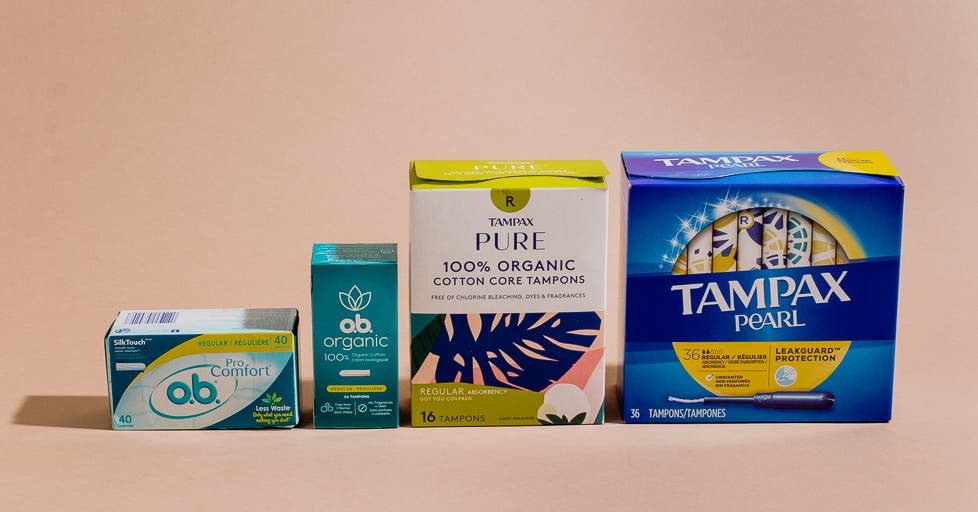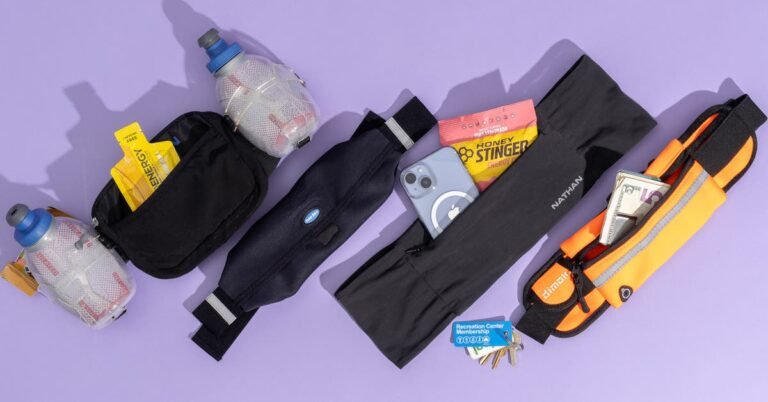Best Tampons
Until recently, tampon manufacturers were not required to disclose exactly what is in their tampons or in what quantities. New York in 2021 became the first state to mandate that all menstrual product makers disclose all of their ingredients, and many other states have started to follow suit. A handful of bills have also proposed that the US Congress require tampon manufacturers to disclose the chemicals and processes they use in manufacturing sanitary products.
Every tampon we tested came with a list of materials noting what the absorbent core was made of (usually rayon or cotton) and what the string consisted of (generally polyester, polypropylene, cotton, or a combination of these materials), as well as, if applicable, the materials in any “fabric overlay”—or “veil”—around the absorbent core, which is meant to prevent fiber shedding (this veil is usually made of polyethylene, polypropylene, or a combination of the two). But these ingredients lists aren’t exhaustive, and they don’t detail how much of any material a tampon is made of (nor whether a tampon might contain any trace elements as a result of manufacturing processes). Applicators generally are listed as being made of a plant-based plastic, plastic, or cardboard, with any dyes listed as “pigments” of undisclosed sources. When we asked the companies that made the tampons we tested to provide complete lists of what went into their products, many reiterated what’s stated on their tampons’ boxes. Tampax pointed us to the trade-association-run repository Smart Label from the US-based Consumer Brands Association and Food & Consumer Products of Canada. (The ingredients listed there are the same as those noted on Tampax boxes.) Solimo, an Amazon brand, forwarded us a screenshot of the side of its tampon box. Other companies chose not to respond at all.
In a July 2024 paper, researchers at the University of California, Berkeley, and their colleagues reported having found metals including lead in every one of the 24 different tampons they tested. Across name brand, store brand, organic, conventional, with applicator, and applicator-free tampons the team tested, “we found really consistent results,” said study coauthor Jenni Shearston, a postdoctoral researcher at UC Berkeley, who added that the findings do not suggest that people should stop using tampons. Cotton is known to accumulate metals and other substances from soil and water, and more research is needed to determine whether the metals detected can leave tampons and enter the body.
It’s hard to find anybody who works on tampons or tampon-related research who isn’t firmly in one of two very opposite camps. Organizations that back holistic and “natural” products, such as the nonprofit Women’s Voices for the Earth, tend to talk about conventional tampons as if they were poison capsules, while researchers at tampon-manufacturing companies maintain that their products are perfectly safe. “All tampon materials and finished products are assessed for safety using the broadly recognized risk-assessment principles established by the US National Academy of Sciences and World Health Organization,” Anne Hochwalt, then a researcher at Procter & Gamble, told us in an interview.
And before you spend your money on organic tampons, keep in mind that a “100% organic” label addresses only how the cotton is grown and sourced (according to USDA standards, if you’re buying such tampons in the US). However, even organic cotton can negatively impact the environment.
Organic tampons are not necessarily processed any differently than tampons made from synthetic materials, and they are not any “safer” from a personal health perspective. Tampon ingredients that tend to give people pause include rayon and dioxins.
Rayon: Many tampons are made from a mix of cotton and rayon. Manufacturers use rayon—a material formed from wood pulp in a chemical process—because it’s more absorbent than cotton and is not a crop, which means that the companies aren’t totally reliant on a plant that might have a bad year and suddenly become more expensive. Some people worry that synthetic fibers increase the risk of toxic shock syndrome because they were implicated in the TSS boom in the late 1970s, but tampon makers no longer use those particular fibers. According to the FDA, the presence of rayon in a tampon does not appear to increase the risk of TSS. The Tampax Pearl ingredient list says that Pearl tampons may include rayon, while Tampax Pure and both of our O.B. picks are free of rayon.
Dioxins: Tampons undergo bleaching during the manufacturing process. This step makes them white in color and also helps remove waxes and anything else that might impede absorption. The FDA now requires tampons to be bleached using what’s called “elemental chlorine-free” processes. That means that the process uses no elemental chlorine gas but might include chlorine dioxide. Although chlorine dioxide is toxic in large doses, it’s safe for bleaching things like tampons and flour, and for disinfecting municipal drinking water.
People worry about bleaching with elemental chlorine because the process can produce dioxins and “dioxin-like compounds.” Dioxins are highly toxic in some doses, and the World Health Organization calls dioxins environmental pollutants. But tampon makers no longer bleach their products with elemental chlorine. The FDA, meanwhile, asks tampon manufacturers to regularly monitor the level of dioxins in their products; the FDA also says that those levels, found in both organic and non-organic tampons, are low enough that they’re not worth worrying about. Plus, dioxins are all around in low levels: Meat, dairy, fish, and shellfish all contain dioxins. In one paper that examined the level of dioxins in both tampons and diapers, the authors conclude that “exposures to dioxins from tampons are approximately 13,000–240,000 times less than dietary exposures.” In other words, don’t worry about it.
Some of the tampons in our test group bear a “chlorine-free” label, which means that the manufacturer doesn’t use chlorine to bleach those tampons (some companies use peroxide instead). Such tampons perform just as well as others, but since the result of bleaching isn’t something you should worry about, a “chlorine-free” designation shouldn’t be a factor in which tampon you pick.
And nothing we read raised health concerns about the materials in the applicators. You can choose between plastic and cardboard based on other parameters without having to think about safety; your choice should come down to comfort and how you feel about the garbage you produce. Although Tampax claims that its cardboard applicators are biodegradable and flushable, many plumbers disagree. Plastic applicators are not biodegradable or recyclable.
Source link
[og_img
Until recently, tampon manufacturers were not required to disclose exactly what is in their tampons or in what quantities. New York in 2021 became the first state to mandate that all menstrual product makers disclose all of their ingredients, and many other states have started to follow suit. A handful of bills have also proposed that the US Congress require tampon manufacturers to disclose the chemicals and processes they use in manufacturing sanitary products.
Every tampon we tested came with a list of materials noting what the absorbent core was made of (usually rayon or cotton) and what the string consisted of (generally polyester, polypropylene, cotton, or a combination of these materials), as well as, if applicable, the materials in any “fabric overlay”—or “veil”—around the absorbent core, which is meant to prevent fiber shedding (this veil is usually made of polyethylene, polypropylene, or a combination of the two). But these ingredients lists aren’t exhaustive, and they don’t detail how much of any material a tampon is made of (nor whether a tampon might contain any trace elements as a result of manufacturing processes). Applicators generally are listed as being made of a plant-based plastic, plastic, or cardboard, with any dyes listed as “pigments” of undisclosed sources. When we asked the companies that made the tampons we tested to provide complete lists of what went into their products, many reiterated what’s stated on their tampons’ boxes. Tampax pointed us to the trade-association-run repository Smart Label from the US-based Consumer Brands Association and Food & Consumer Products of Canada. (The ingredients listed there are the same as those noted on Tampax boxes.) Solimo, an Amazon brand, forwarded us a screenshot of the side of its tampon box. Other companies chose not to respond at all.
In a July 2024 paper, researchers at the University of California, Berkeley, and their colleagues reported having found metals including lead in every one of the 24 different tampons they tested. Across name brand, store brand, organic, conventional, with applicator, and applicator-free tampons the team tested, “we found really consistent results,” said study coauthor Jenni Shearston, a postdoctoral researcher at UC Berkeley, who added that the findings do not suggest that people should stop using tampons. Cotton is known to accumulate metals and other substances from soil and water, and more research is needed to determine whether the metals detected can leave tampons and enter the body.
It’s hard to find anybody who works on tampons or tampon-related research who isn’t firmly in one of two very opposite camps. Organizations that back holistic and “natural” products, such as the nonprofit Women’s Voices for the Earth, tend to talk about conventional tampons as if they were poison capsules, while researchers at tampon-manufacturing companies maintain that their products are perfectly safe. “All tampon materials and finished products are assessed for safety using the broadly recognized risk-assessment principles established by the US National Academy of Sciences and World Health Organization,” Anne Hochwalt, then a researcher at Procter & Gamble, told us in an interview.
And before you spend your money on organic tampons, keep in mind that a “100% organic” label addresses only how the cotton is grown and sourced (according to USDA standards, if you’re buying such tampons in the US). However, even organic cotton can negatively impact the environment.
Organic tampons are not necessarily processed any differently than tampons made from synthetic materials, and they are not any “safer” from a personal health perspective. Tampon ingredients that tend to give people pause include rayon and dioxins.
Rayon: Many tampons are made from a mix of cotton and rayon. Manufacturers use rayon—a material formed from wood pulp in a chemical process—because it’s more absorbent than cotton and is not a crop, which means that the companies aren’t totally reliant on a plant that might have a bad year and suddenly become more expensive. Some people worry that synthetic fibers increase the risk of toxic shock syndrome because they were implicated in the TSS boom in the late 1970s, but tampon makers no longer use those particular fibers. According to the FDA, the presence of rayon in a tampon does not appear to increase the risk of TSS. The Tampax Pearl ingredient list says that Pearl tampons may include rayon, while Tampax Pure and both of our O.B. picks are free of rayon.
Dioxins: Tampons undergo bleaching during the manufacturing process. This step makes them white in color and also helps remove waxes and anything else that might impede absorption. The FDA now requires tampons to be bleached using what’s called “elemental chlorine-free” processes. That means that the process uses no elemental chlorine gas but might include chlorine dioxide. Although chlorine dioxide is toxic in large doses, it’s safe for bleaching things like tampons and flour, and for disinfecting municipal drinking water.
People worry about bleaching with elemental chlorine because the process can produce dioxins and “dioxin-like compounds.” Dioxins are highly toxic in some doses, and the World Health Organization calls dioxins environmental pollutants. But tampon makers no longer bleach their products with elemental chlorine. The FDA, meanwhile, asks tampon manufacturers to regularly monitor the level of dioxins in their products; the FDA also says that those levels, found in both organic and non-organic tampons, are low enough that they’re not worth worrying about. Plus, dioxins are all around in low levels: Meat, dairy, fish, and shellfish all contain dioxins. In one paper that examined the level of dioxins in both tampons and diapers, the authors conclude that “exposures to dioxins from tampons are approximately 13,000–240,000 times less than dietary exposures.” In other words, don’t worry about it.
Some of the tampons in our test group bear a “chlorine-free” label, which means that the manufacturer doesn’t use chlorine to bleach those tampons (some companies use peroxide instead). Such tampons perform just as well as others, but since the result of bleaching isn’t something you should worry about, a “chlorine-free” designation shouldn’t be a factor in which tampon you pick.
And nothing we read raised health concerns about the materials in the applicators. You can choose between plastic and cardboard based on other parameters without having to think about safety; your choice should come down to comfort and how you feel about the garbage you produce. Although Tampax claims that its cardboard applicators are biodegradable and flushable, many plumbers disagree. Plastic applicators are not biodegradable or recyclable.
The Best Tampons of 2025
[title_words_as_hashtags



